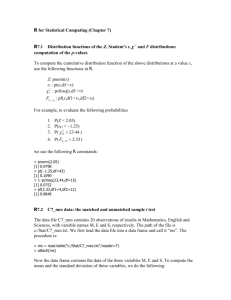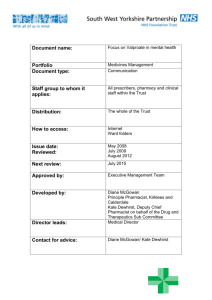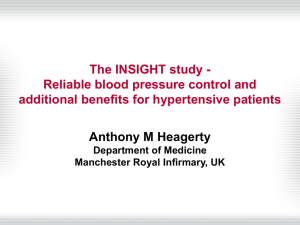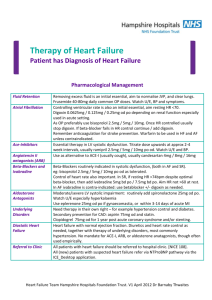03 - Umesh G Wari - journal of evidence based medicine and
advertisement
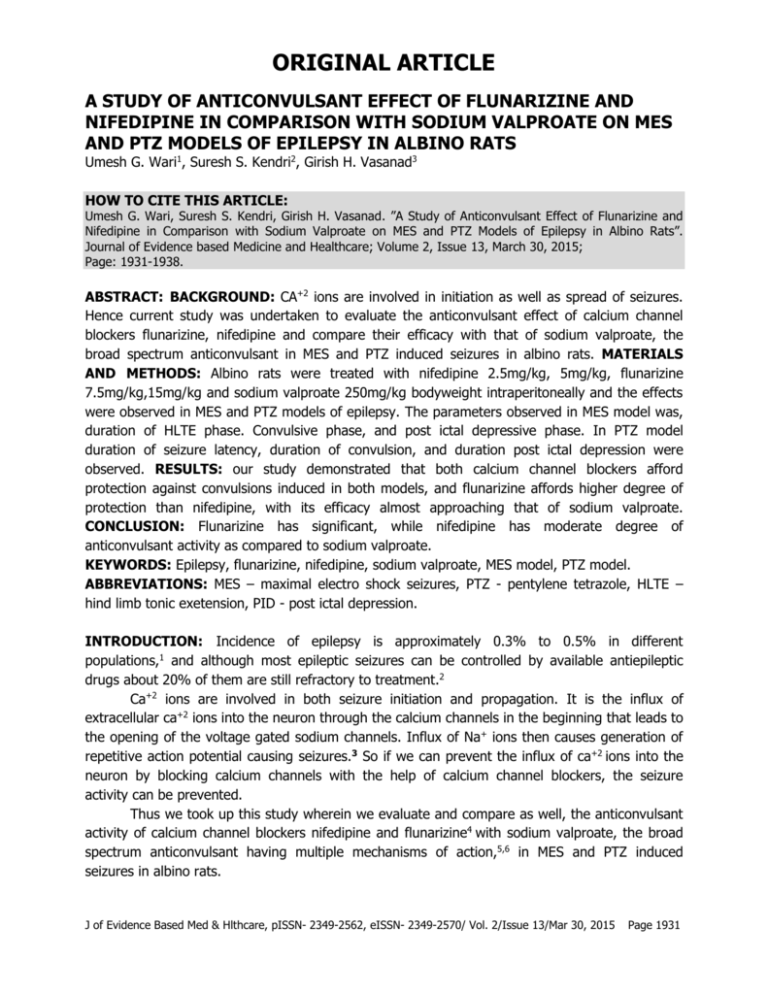
ORIGINAL ARTICLE A STUDY OF ANTICONVULSANT EFFECT OF FLUNARIZINE AND NIFEDIPINE IN COMPARISON WITH SODIUM VALPROATE ON MES AND PTZ MODELS OF EPILEPSY IN ALBINO RATS Umesh G. Wari1, Suresh S. Kendri2, Girish H. Vasanad3 HOW TO CITE THIS ARTICLE: Umesh G. Wari, Suresh S. Kendri, Girish H. Vasanad. ”A Study of Anticonvulsant Effect of Flunarizine and Nifedipine in Comparison with Sodium Valproate on MES and PTZ Models of Epilepsy in Albino Rats”. Journal of Evidence based Medicine and Healthcare; Volume 2, Issue 13, March 30, 2015; Page: 1931-1938. ABSTRACT: BACKGROUND: CA+2 ions are involved in initiation as well as spread of seizures. Hence current study was undertaken to evaluate the anticonvulsant effect of calcium channel blockers flunarizine, nifedipine and compare their efficacy with that of sodium valproate, the broad spectrum anticonvulsant in MES and PTZ induced seizures in albino rats. MATERIALS AND METHODS: Albino rats were treated with nifedipine 2.5mg/kg, 5mg/kg, flunarizine 7.5mg/kg,15mg/kg and sodium valproate 250mg/kg bodyweight intraperitoneally and the effects were observed in MES and PTZ models of epilepsy. The parameters observed in MES model was, duration of HLTE phase. Convulsive phase, and post ictal depressive phase. In PTZ model duration of seizure latency, duration of convulsion, and duration post ictal depression were observed. RESULTS: our study demonstrated that both calcium channel blockers afford protection against convulsions induced in both models, and flunarizine affords higher degree of protection than nifedipine, with its efficacy almost approaching that of sodium valproate. CONCLUSION: Flunarizine has significant, while nifedipine has moderate degree of anticonvulsant activity as compared to sodium valproate. KEYWORDS: Epilepsy, flunarizine, nifedipine, sodium valproate, MES model, PTZ model. ABBREVIATIONS: MES – maximal electro shock seizures, PTZ - pentylene tetrazole, HLTE – hind limb tonic exetension, PID - post ictal depression. INTRODUCTION: Incidence of epilepsy is approximately 0.3% to 0.5% in different populations,1 and although most epileptic seizures can be controlled by available antiepileptic drugs about 20% of them are still refractory to treatment.2 Ca+2 ions are involved in both seizure initiation and propagation. It is the influx of extracellular ca+2 ions into the neuron through the calcium channels in the beginning that leads to the opening of the voltage gated sodium channels. Influx of Na+ ions then causes generation of repetitive action potential causing seizures.3 So if we can prevent the influx of ca+2 ions into the neuron by blocking calcium channels with the help of calcium channel blockers, the seizure activity can be prevented. Thus we took up this study wherein we evaluate and compare as well, the anticonvulsant activity of calcium channel blockers nifedipine and flunarizine4 with sodium valproate, the broad spectrum anticonvulsant having multiple mechanisms of action,5,6 in MES and PTZ induced seizures in albino rats. J of Evidence Based Med & Hlthcare, pISSN- 2349-2562, eISSN- 2349-2570/ Vol. 2/Issue 13/Mar 30, 2015 Page 1931 ORIGINAL ARTICLE MATERIALS AND METHODS: Nifedipine in the dose of 2.5mg\kg, and 5mg\kg, flunarizine in the dose of 7.5mg\kg, and 15 mg\kg, sodium valproate in the dose of 250mg\kg were used, the solvent used was propylene glycol, for all the three drugs. The dose of nifedipine and sodium valproate was calculated from human doses extrapolating onto albino rats depending on the body surface area. The dose of flunarizine was calculated from the dose used in a previous study,7 conducted on mice, again the dose was converted accordingly depending on the body surface area. Albino wistar rats of either sex of average weight 150gm to 250gm which were in bred in central animal house of JJMMC were used for experimentation. The study was done after getting the clearance of institutional animal ethical committee. All the animals were allowed food and water add libitum both being withdrawn just prior to experiment. The animals were housed in polypropylene cage under standard conditions in dim light and noise free room. The above test animals were divided into two major groups, one group was subjected to electroshock of 150 m A, 50 HZ for 0.2 seconds, through ear electrodes for MES model.8 Only those animals that showed convulsive response were used for the study. They were divided into six groups of six each. Remaining group of test animals was used for chemoshock that is PTZ model9 and they were also divided into six groups of six rats each. All the test animals were subjected to further study after a gap of 24 hours to prevent any possible kindling effect. All the drugs were given intraperitoneally, except for PTZ used in a dose of 70 mg\kg bodyweight was administered subcutaneously. All the drugs were given to the predetermined corresponding groups with propylene glycol acting as control. The drugs were given 30 minutes before being subjected to MES stimulus in MES model. Similarly all the drugs were given 30 minutes prior to the administration of PTZ in chemoshock group. The parameters observed in MES model were, duration of HLTE phase, duration of convulsion and post ictal depression, the parameters observed in PTZ model were duration of seizure latency, duration of convulsion, and post ictal depression. STATISTICAL ANALYSIS: All the data obtained were tabled as mean and standard error of mean, the data were analysed using one way ANOVA test followed by dunnetts multiple comparisons test. RESULTS: In MES model, there was highly significant reduction in the duration of HLTE phase, duration of convulsion and postictal depression, with flunarizine in the dose of 15mg\kg, with p value <0.0001, whereas at the dose of 7.5mg\kg the reduction in all the three parameters were significant with a p value <0.001 With nifedipine in the dose of 5mg\kg there was a significant reduction in the duration of all the three parameters with a p value of <0.001 but whereas with the dose of 2.5mg\kg the reduction in the parameters were not statistically significant. J of Evidence Based Med & Hlthcare, pISSN- 2349-2562, eISSN- 2349-2570/ Vol. 2/Issue 13/Mar 30, 2015 Page 1932 ORIGINAL ARTICLE The efficacy of flunarizine in the dose of 15mg\kg almost approached that of sodium valproate in respect to all the three parameters. There was no statistical difference between the two drugs at the above mentioned dose of flunarizine with respect to their efficacy. PTZ model;, even in PTZ model also flunarizine at the dose of 15mg\kg increased latency period of onset of seizures, reduced the duration of convulsion and reduced the post ictal depression phase duration, with a very high significant p value of <.0001, in the dose of 7.5mg\kg it increased the seizure latency period significantly and there was significant reduction in the duration of the other two parameters with p value of <.001 With nifedipine in the dose of 5mg\kg there was significant increase in the seizure latency period, and there was significant reduction in the duration of convulsion, and that of post ictal depression period. With a p value of <.001, but in the dose of 2.5mg\kg it showed no statistically significant results in all the three parameters. In this model also the efficacy of flunarizine in the dose of 15mg\kg was comparable to that of standard antiepileptic drug sodium valproate. DISCUSSION: Because of involvement of ca+2 ions in the generation of impulse, its conduction, and contractility of heart and also because they are involved in maintaining the tone of the blood vessels, the calcium channel blockers have established themselves as first line of drugs in many of the cardiovascular diseases.10 As discussed above the calcium ions are also involved in neuronal excitability hence these calcium channel blockers can play a significant role in reducing the excitability of the neurons, they in a way can help in calming down of repetitively firing neurons. Calcium channel blockers like flunarizine and nifedipine block L and T type of calcium channels with flunarizine having greater potency.10 Of late it has been found in recent studies that flunarizine blocks Na+ channels also.7 In our study fluanarizine showed dose dependent increase in its potency, and its efficacy almost approaching that of sodium valproate. These observations can be explained by the fact that flunarizine acts by multiple mechanisms and also has got higher affinity for blocking calcium channels. Whereas nifedipine has got moderate efficacy as an anticonvulsant may be because it acts by blocking calcium channels only, and also its affinity for blocking calcium channels is not as strong as flunarizine. CONCLUSION: Both flunarizine and nifedipine have got anticonvulsant activity with flunarizine having efficacy comparable to that of sodium valproate. Flunarizine may well act as an additional anticonvulsant in future, its potential as an anticonvulsant is yet to be tapped. But for that to happen further studies are needed in humans as controls. REFERENCES: 1. Daniel H Lowenstein. Seizures and Epilepsy, in Harrisons Principles of Internal Medicine – Braunwald, Wilson, Martin, vol. 2, 16th edition, pp.2357 – 2371. 2. Sharma HL, Sharma KK, Antiepileptic Drugs, in Principles Of Pharmacology, 2nd edition, Paras Publications 2011. pp. 529 – 543. J of Evidence Based Med & Hlthcare, pISSN- 2349-2562, eISSN- 2349-2570/ Vol. 2/Issue 13/Mar 30, 2015 Page 1933 ORIGINAL ARTICLE 3. Heinemann U Hamon, Calcium and Epileptogenesis. Exp Brain Res 1986; 65: 1 – 10. 4. Todd PA, Benfield P. Flunarizine - A reappraisal of its pharmacological properties and therapeutic uses in neurological disorders. Drugs 1989; 38: 481 – 499. 5. Johanessen Lu. Valproate; past, present and future. CNS Drug Rev 2003 p 200 – 216. 6. Meldrum BS, Simiond J. Mechanism of anticonvulsant action of valproate. Drug Neuro Biol 1982; 19: 315 -359. 7. Fischer W, Kittner H, Regenethal R, De Sarro G. Anticonvulsant profile of flunarizine and relation to Na+ channel blocking effects. Basic And Clinical Pharmacology And Toxicology 2004; 94: 79 – 88. 8. Castel Branco MM, Alves GL, Figueirido IV, Falcao AC. The maximal electroshockseizure (MES) model in the preclinical assessment of potential new antiepileptic drugs. Methods Find Exp Clin Pharmacol 2009; 31(2): 101 – 106. 9. Peter P, Deyn De, Hooge DR, Marescau B, Quan Pe Y. C hemical models of epilepsy with some reference to their applicability in the development of anticonvulsants. Epilepsy Research 1992; 12: 87 – 110. 10. Desai SJ, Kulkarni VN, Shankar PS. Therapeutic applications of calcium channel blockers in cardiovascular disorders. Indian J Clin Pharmacol Ther 1999; 19: 34 – 39. Drug (mg\kg), i.p Control (propylene glycol) Sodium valproate 250mg\kg Flunarizine 7.5mg\kg Flunarizine 15mg\kg Nifedipine 2.5mg\kg Nifedipine 5mg\kg Duration Of HLTE Duration Of convulsion Duration of PID 13.66±0.55 32±1.46 46.33±1.12 3.66±0.33 13±0.36 20±0.85 8.5±0.42·* 22.16±0.98* 24±1.15* 4.5±0.42** 14.16±0.60** 22.66±0.99** 10.66±0.49 25.33±0.70 38.66±2.88 8.16±0.30* 20.5±0.76* 33.66±0.95* Table 1: Effects of sodium valproate, flunarizine, nifedipine, on MES model. All the values are in mean±SEM. All the durations are in seconds. *indicates p value <0.001 i.e significant. **indicates p value <0.0001 i.e highly significant. J of Evidence Based Med & Hlthcare, pISSN- 2349-2562, eISSN- 2349-2570/ Vol. 2/Issue 13/Mar 30, 2015 Page 1934 ORIGINAL ARTICLE Drug mg\kg, i.p Control (propylene glycol) Sodium valproate 250mg\kg Flunarizine 7.5mg\kg Flunarizine 15mg\kg NIfedipine 2.5mg\kg Nifedipine 5mg\kg Seizure latency Duration of convulsion Duration of PID 110.33± 6.01 26.5 ± 0.88 80.16 ± 1.78 160.66 ± 3.08 9.33 ± 0.61 18.16 ± 0.65 141.66 ± 2.18* 15.16± 0.95* 34.66 ± 0.71* 153.33 ± 3.47** 10.66 ± 0.51** 21.16 ± 0.96** 129.66 ± 5.62 19.5± 0.84 40.83 ± 0.98 136.33 ± 2.67* 13.16± 0.75* 25.16 ±1.08* Table 2: Effects of sodium valproate, flunarizine and nifedipine on PTZ model. PTZ was used in the dose of 70mg\kg s.c. All the values are in mean±SEM. All the durations are in seconds. *indicates p value <0.001 i.e significant. **indicates p value <0.0001 i.e highly significant. Fig. 1: Showing the effect of sodium valproate, flunarizine, and nifedipine, on duration of HLTE phase in MES model C –control, s v – sodium valproate, f- flunarizine N- nifedipine. Y-axis indicates the mean duration in seconds. J of Evidence Based Med & Hlthcare, pISSN- 2349-2562, eISSN- 2349-2570/ Vol. 2/Issue 13/Mar 30, 2015 Page 1935 ORIGINAL ARTICLE Fig. 2: Showing the effect of sodium valproate, flunarizine, and nifedipine, on duration of convulsion in MES model C-control, sv –sodium valproate, f – flunarizine, N- nifedipine, Y-axis indicates the mean duration in seconds. Fig. 3: Showing the effect of sodium valproate, flunarizine, and nifedipine on duration of PID in MES model Y-axis indicates the mean duration of the drugs in seconds. J of Evidence Based Med & Hlthcare, pISSN- 2349-2562, eISSN- 2349-2570/ Vol. 2/Issue 13/Mar 30, 2015 Page 1936 ORIGINAL ARTICLE Fig. 4: Effects of sodium valproate, flunarizine, and nifedipine, on duration of seizure latency in PTZ model Y – axis indicates the mean duration of seizure latency in seconds. *indicates p value <0.001. i.e significant, ** indicates p value <0.0001 i.e highly significant. Fig. 5: Showing the effects of sodium valproate, flunarizine, and nifedipine, on duration of convulsion in PTZ model y- axis indicates the mean duration of convulsion in seconds. *indicates p value <0.001 i.e significant. ** indicates p value <0.0001 i.e highly significant. J of Evidence Based Med & Hlthcare, pISSN- 2349-2562, eISSN- 2349-2570/ Vol. 2/Issue 13/Mar 30, 2015 Page 1937 ORIGINAL ARTICLE Fig. 6: Showing the effects of sodium valproate, flunarizine, and nifedipine on duration of PID in PTZ model Y – axis indicates the mean duration of PID in seconds, *indicates the p value <0.001 i.e significant, ** indicates the p value <0.0001 i.e highly significant. AUTHORS: 1. Umesh G. Wari 2. Suresh S. Kendri 3. Girish H. Vasanad PARTICULARS OF CONTRIBUTORS: 1. Associate Professor, Department of Pharmacology, VIMS, Bellary, Karnataka. 2. Associate Professor, Department of Pharmacology, VIMS, Bellary, Karnataka. 3. Assistant Professor, Department of Pharmacology, SNMC & HSKRC, Bagalkot. NAME ADDRESS EMAIL ID OF THE CORRESPONDING AUTHOR: Dr. Umesh G. Wari, Associate Professor, Department of Pharmacology, VIMS, Bellary-583104, Karnataka. E-mail: umeshwaribly@rediffmail.com Date Date Date Date of of of of Submission: 14/03/2015. Peer Review: 16/03/2015. Acceptance: 19/03/2015. Publishing: 24/03/2015. J of Evidence Based Med & Hlthcare, pISSN- 2349-2562, eISSN- 2349-2570/ Vol. 2/Issue 13/Mar 30, 2015 Page 1938



